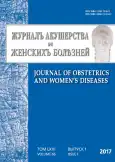Effect on ovarian reserve using various techniques to reduce blood loss for myomectomy
- Authors: Tsivyan B.L1, Troik E.B1, Mekoshvili C.V1, Konstantinova E.V1
-
Affiliations:
- North-Western State Medical University named after I.I. Mechnikov
- Issue: Vol 66, No 1 (2017)
- Pages: 32-37
- Section: Articles
- URL: https://journals.rcsi.science/jowd/article/view/6093
- DOI: https://doi.org/10.17816/JOWD66132-37
- ID: 6093
Cite item
Full Text
Abstract
Keywords
Full Text
##article.viewOnOriginalSite##About the authors
Boris L Tsivyan
North-Western State Medical University named after I.I. Mechnikov
Author for correspondence.
Email: btsivyan@mail.ru
PhD, professor assistant, Departament of Obstetrics and Gynecology named after S.N. Davidov Russian Federation
Eugenia B Troik
North-Western State Medical University named after I.I. Mechnikov
Email: Troik@spbmapo.ru
MD, Head of the Departament of Obstetrics and Gynecology named after S.N. Davidov Russian Federation
Cristina V Mekoshvili
North-Western State Medical University named after I.I. Mechnikov
Email: kmkm@inbox.ru
graduate student, Departament of Obstetrics and Gynecology named after S.N. Davidov Russian Federation
Elena V Konstantinova
North-Western State Medical University named after I.I. Mechnikov
Email: smallkonstant@mail.ru
graduate student, Departament of Obstetrics and Gynecology named after S.N. Davidov Russian Federation
References
- Buttram VJ, Reiter R. Uterine leiomyomata: etiology, symptomatology, and management. Fertil Steril. 1981;36:433-45.
- Verkauf BS. Myomectomy for fertility enhancement and preservation. Fertil Steril. 1992;58:1-15.
- Mais V, Ajossa S, Guerriero S, et al. Laparoscopic versus abdominal myomectomy: a prospective, randomized trial to evaluate benefits in early outcome. Am J Obstet Gynecol. 1996;174:654-8.
- Ecker JL, Foster JT, Friedman AJ. Abdominal hysterectomy or abdominal myomectomy for symptomatic leiomyoma: a comparison of preoperative demography and postoperative morbidity. J Gynecol Surg. 1995;11:11-8.
- Iverson RE, Chelmow D, Strohbehn K, et al. Relative morbidity of abdominal hysterectomy and myomectomy for management of uterine leiomyomas. Obstet Gynecol. 1996;88:415-9.
- Jin C, Hu Y, Chen XC, et al. Laparoscopic versus open myomectomy: a meta-analysis of randomized controlled trials. Eur J Obstet Gynecol Reprod Biol. 2009;145:14-21. doi: 10.1016/j.ejogrb.2009.03.009.
- Ravina JH, Herbreteau D, Ciraru-Vigneron N, et al. Arterial embolization to treat uterine myomata. Lancet. 1995;346:671-2.
- Goodwin SC, Spies JB, Worthington-Kirsch R, et al. Uterine artery embolization for treatment of leiomyomata: long-term outcomes from the fibroid registry. Obstet Gynecol. 2008;111:22-33. doi: 10.1097/01.AOG.0000296526.71749.c9.
- Myers ER, Goodwin S, Landow W, et al. Prospective data collection of a new procedure by a specialty society: the FIBROID registry. Obstet Gynecol. 2005;106:44-51. doi: 10.1097/01.AOG.0000165827.66541.dd.
- Pron G, Bennett J, Common A, et al. The Ontario uterine fibroid embolization trial, part 2: uterine fibroid reduction and symptom relief after uterine artery embolization for fibroids. Fertil Steril. 2003;79:120-7.
- Huang JY, Kafy S, Dugas A, et al. Failure of uterine fibroid embolization. Fertil Steril. 2006;85:30-5. doi: 10.1016/j.fertnstert.2005.03.091.
- Hald K, Kløw NE, Qvigstad E, Istre O. Laparoscopic occlusion compared with embolization of uterine vessels: a randomized controlled trial. Obstet Gynecol. 2007;109: 20-7. doi: 10.1097/01.AOG.0000249602.39339.31.
- Edwards RD, Moss JG, Lumsden MA, et al. Uterine-artery embolization versus surgery for symptomatic uterine fibroids. N Engl J Med. 2007;356:360-70. doi: 10.1056/NEJMoa062003.
- Parker WH. Uterine myomas: management. Fertil Steril. 2007;88:255-71. doi: 10.1016/j.fertnstert.2007.06.044.
- Tulandi T. Treatment for uterine fibroids – is surgery obsolete? N Engl J Med. 2007;356:411-13. doi: 10.1056/NEJMe068281.
- McLucas B, Danzer H, Wambach C, Lee C. Ovarian reserve following uterine artery embolization in women of reproductive age: a preliminary report. Minim Invasive. There Allied Technol. 2013;22(1):45-9. doi: 10.3109/13645706.2012.743918.
- Seifer DB, Baker VL, Leader B. Age-specific serum anti-müllerian hormone values for 17120 women presenting to fertility centers within the United States. Fertil Steril. 2011;95(2):747-50. doi: 10.1016/j.fertnstert.2010.10.011.
- Farquhar CM, Sadler L, Harvey SA, Stewart AW. The association of hysterectomy and menopause: a prospective cohort study. BJOG. 2005;112(7):956-62. doi: 10.1111/j.1471-0528.2005.00696.x.
- Hehenkamp WJK, Volkers NA, Broekmans FJM, et al. Loss of ovarian reserve after uterine artery embolization: a randomized comparison with hysterectomy. Hum Reprod. 2007;22(7):1996-2005. doi: 10.1093/humrep/dem105.
- Riggs RM, Duran EH, Baker MW, et al. Assessment of ovarian reserve with anti-müllerian hormone: a comparison of the predictive value of anti-müllerian hormone, follicle-stimulating hormone, inhibin B, and age. Am J Obstet Gynecol. 2008;199(2):202-10. doi: 10.1016/j.ajog.2008.05.004.
- Fanchin R, Schonäuer LM, Righini C, et al. Serum anti-müllerian hormone is more strongly related to ovarian follicular status than serum inhibin B, estradiol, FSH and LH on day 3. Hum Reprod. 2003;18(2):323-7.
- Testing and interpreting measures of ovarian reserve: a committee opinion. Practice Committee of the American Society for Reproductive medicine. Fertil Steril. 2012;98(6):1407-15. doi: 10.1016/j.fertnstert.2012.09.036.
- Spies JB, Roth AR, Gonsalves SM, Murphy-Skrzyniarz KM. Ovarian function after uterine artery embolization for leiomyomata: assessment with use of serum follicle stimulating hormone assay. J Vasc Interv Radiol. 2001;12(4):437-42.
Supplementary files







